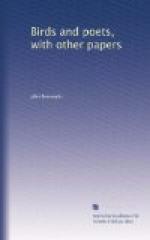“Where the heifers browse—where
geese nip their food with short
jerks;
Where sun-down shadows lengthen over the
limitless and lonesome
prairie;
Where herds of buffalo make a crawling
spread of the square miles
far and near;
Where the splash of swimmers and divers
cools the warm noon;
Where the katydid works her chromatic
reed on the walnut-tree
over the well.”
“Spar-makers in the spar-yard, the swarming
row of well-grown
apprentices,
The swing of their axes on the square-hew’d
log, shaping it toward
the shape of a mast,
The brisk short crackle of the steel driven
slantingly into the pine,
The butter-color’d chips flying
off in great flakes and slivers,
The limber motion of brawny young arms
and hips in easy costumes.”
“Always these compact lands—lands
tied at the hips with the belt
stringing the huge oval
lakes.”
“Far breath’d land! Arctic
braced! Mexican breez’d!—the
diverse!
the compact!”
Tried by the standards of the perfect statuesque poems, these pages will indeed seem strange enough; but viewed as a part of the poetic compend of America, the swift gathering-in, from her wide-spreading, multitudinous, material life, of traits and points and suggestions that belong here and are characteristic, they have their value. The poet casts his great seine into events and doings and material progress, and these are some of the fish, not all beautiful by any means, but all terribly alive, and all native to these waters.
In the “Carol of Occupations” occur, too, those formidable inventories of the more heavy and coarsegrained trades and tools that few if any readers have been able to stand before, and that have given the scoffers and caricaturists their favorite weapons. If you detach a page of these and ask, “Is it poetry? have the ‘hog-hook,’ the ‘killing-hammer,’ ‘the cutter’s cleaver,’ ’the packer’s maul,’ met with a change of heart, and been converted into celestial cutlery?” I answer, No, they are as barren of poetry as a desert is of grass; but in their place in the poem, and in the collection, they serve as masses of shade or neutral color in pictures, or in nature, or in character,—a negative service, but still indispensable. The point, the moral of the poem, is really backed up and driven home by this list. The poet is determined there shall be no mistake about it. He will not put in the dainty and pretty things merely,—he will put in the coarse and common things also, and he swells the list till even his robust muse begins to look uneasy. Remember, too, that Whitman declaredly writes the lyrics of America, of the masses, of democracy, and of the practical labor of mechanics, boatmen, and farmers:—




